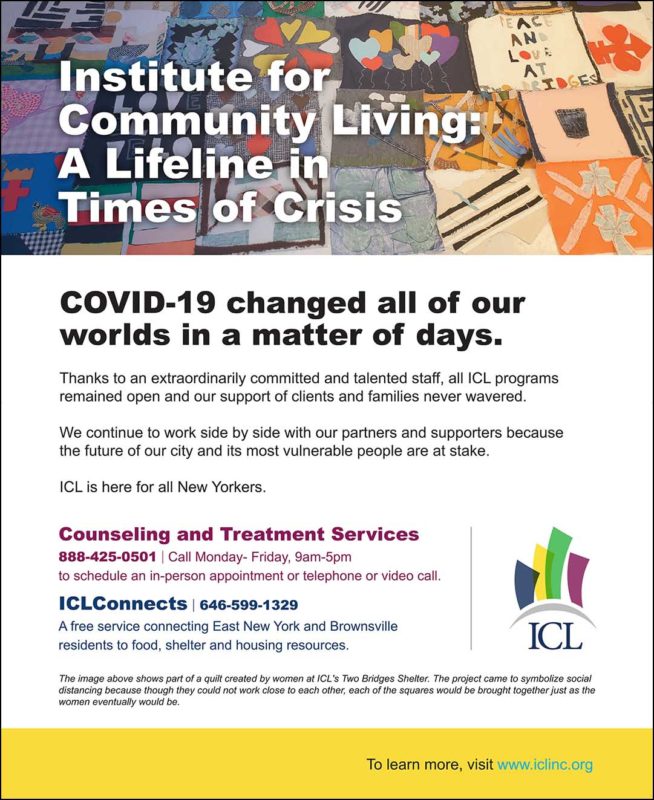In New York City, tens of thousands of people with serious mental illness or developmental disabilities live in congregate housing or homeless shelters. For behavioral health agencies like the Institute for Community Living (ICL), the COVID-19 pandemic has presented an urgent challenge: With over 1,500 people living in congregate settings, the protection of residents was our paramount concern. We knew that would be extremely difficult for a number of reasons, the first and most important of which is the level of vulnerability of the populations living in our residential programs.

Cynthia Summers, DrPH, MPH

Jeanie Tse, MD
Residents in these facilities are among the very highest risk populations. To start with, people with schizophrenia and other serious mental illnesses have a life expectancy that is 25 years shorter than the general population because of higher rates of co-morbid medical conditions including obesity, type 2 diabetes, hypertension, dyslipidemia and nicotine dependence. People with intellectual and developmental disabilities also experience significantly greater morbidity and earlier mortality.
The significant vulnerabilities of people living with serious mental illness are further compounded by the physical and emotional impact of trauma so many have experienced. In addition, many of these individuals and their families have been affected by what are collectively referred to as social determinants of health, the results of living in poverty with a lack of adequate housing, education and nutrition, often amidst community and family violence, racism and discrimination. In New York City, people in congregate housing settings are disproportionately male, black, older, obese, hypertensive and smokers. All of these characteristics have been associated with COVID-19 morbidity and mortality. So, in a tragic sense, housing for these populations offered the perfect storm for the spread of this deadly virus.
This pandemic imposed unprecedented challenges to all of ICL’s housing programs, whose first priority instantaneously became keeping people healthy. And for those who became ill, we had to quickly develop protocols to care for them without compromising the rest of the community, clients and staff alike. An added danger for shelters is the fact that their clients are very transient with new residents entering on a daily basis. We knew the people in our care would be among the hardest hit by the spread and virulence of COVID-19.
Strategies and Tactics Implemented
So how did we take charge of a situation that was escalating steadily in danger and complexity?
Early on, ICL set up an emergency response and strategy team that meets 7 days per week. Their charge was to monitor the pandemic, mitigate risk to clients and staff, plan for potential scenarios and situations, and ensure rapid dissemination of information, protocols and regulation changes. The following measures were taken:
- Increased facilities cleaning and availability of hand sanitizer
- Restricted visitors from residences
- Set up screening and isolation procedures for fever and cough
- Contactless temperature screening for residences for people with intellectual and developmental disabilities
- Tracking of reported symptoms and exposures, followed by contact tracing
- Collaboration with Department of Homeless Services to isolate shelter residents in hotels
- Enabled and mandated telecommuting for as many staff as possible across the agency
- Delivered outpatient services via telehealth
- Distributed donated masks to residences and shelters with highest number of cases and greatest crowding (unable to purchase masks in the first month of the crisis)
- Focused efforts on ensuring adequate staffing at programs with high prevalence of sick or exposed staff
Data Collection to Guide Present and Future
We knew that information gathering would be very important for our future planning and to share with the field, so we began a data collection effort to understand the impact of COVID-19 on different populations and how staff and clients were being impacted by changes in practice (e.g., the shift to telehealth and telecommuting).
We have already learned a number of important lessons about people living and working in behavioral health housing and treatment programs. A high incidence of infection was found, with the highest infection rate among people with intellectual and developmental disabilities; these clients had the greatest direct contact with staff and significant challenges with physical distancing and isolation. On the other hand, the tendency of people with serious mental illnesses to self-isolate may be protective in the setting of a pandemic. For this population, behavioral health workers visiting them in their homes may paradoxically present a risk of viral transmission. In this way, isolation to avoid infection runs counter to ICL’s usual work in helping people engage with the community, and we will need to redouble these efforts once the pandemic passes.
On the other hand, perhaps telehealth is one solution to chronic social isolation. Our early data show that we are speaking with our clients more than ever before. Some clients who have had difficulty attending appointments due to chronic pain or disabling depression are now able to meet regularly on the phone. We are learning more about best practices around telehealth, but one thing appears certain: there will be a number of clients who will not want to return solely to face-to-face visits in the future.
We know that people with mental illness and developmental disabilities suffer extraordinary health disparities. Strategies to prevent an outbreak in these underserved populations are needed. Housing and homeless policies and practices, constrained as they are by the population density in New York City, need to consider the risk of contagion in group settings, with long-term implementation of personal protective equipment and physical distancing measures. Prioritizing widespread testing will expand the ability to control infections. Integrating primary care with behavioral health care will support the ability of behavioral health agencies to provide this testing and treat disease. Finally, creating more affordable/supported apartment housing will reduce the need for congregate housing, while supporting quality of life.
Where Do We Go from Here?
The primary focus of our agency continues to be keeping our current residents and staff healthy and getting those who are ill the medical attention they require. At the same time, we are actively planning for the next phase of ICL operations as the city slowly recovers and reopens. We look forward to working with our partners in the community as well as the government entities involved in the care of the people we serve. We must work collaboratively and creatively to come up with the changes and practices to continue fighting this virus and to be prepared for future challenges that can, as COVID-19 did, shake our institutions to the core.
Together we can come up with longer term solutions that ensure outstanding care that takes into account the critical factors that lead to better health and recovery. This in turn will enable us to continue to break through the generations-long stronghold on our community’s health, particularly for people with the greatest health and behavioral health challenges.







